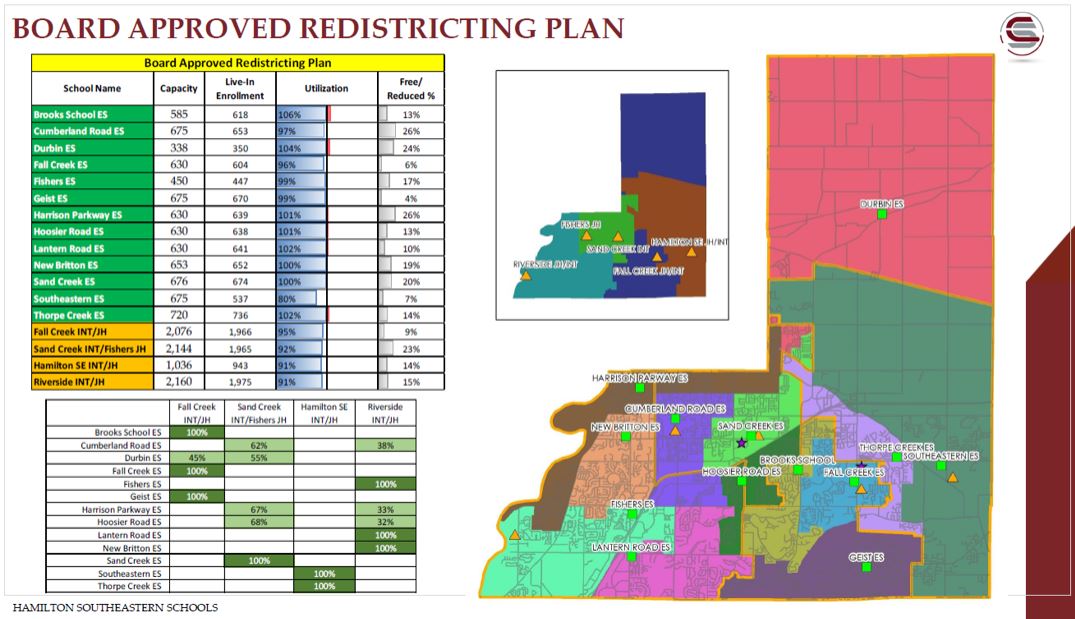I attended the December 12th, 2018 Hamilton Southeastern Schools Board meeting. This was expected to be an interesting meeting because the board was to approve the redistricting plans that had been developed over the previous months. Additionally, it was to be the last official board meeting for three of the seven members whose tenure ends at the end of the month.
I attempted to capture video of this meeting; however, I had limited success. I worked with a new camera, so while the video quality is better than the cell phone I’ve used in the past, I’m clearly still learning to use the camera. Additionally, I can’t control the audience around me, including the tiny kids that had been brought to the meeting that were right behind me.
Redistricting HSE Schools
The primary topic of the meeting was redistricting. Like the previous school board meeting, the HSE Superintendent, Dr. Bourff, presented a recommendation for the school board to consider. This was the same recommendation that he made at the previous school board meeting. Unlike the previous meeting, he also included several possible amendments to the proposal. You can catch my video of Dr. Bourff presenting here (sorry for the low audio in this snippet):
The first option Dr. Bourff presented as a change to the proposed redistricting plan was to move Logan’s Pointe from Southeastern elementary School and HIJH over to Durbin Elementary School and Fall Creek Intermediate/Junior High. This only impacted 19 students. This proposed change was passed by the school board.
The second option for change was to move Sunlake apartments to Harrison Parkway, and the “River” neighborhoods to New Britton Elementary School. This proposal had received a lot of discussion. This proposal would have put the “River” neighborhoods back into New Britton. The irony is that Sunlake kids would likely have to drive past New Britton to get to Harrison Parkway once the construction on 37 starts. This proposal failed to pass.
A third option for change was to move the Anchorage neighborhood from Geist Elementary School to Brook School Elementary School. This proposal only impacted 6 students that currently attend Geist. This proposed change was passed by the school board.
The fourth and final potential option for change in the proposed redistricting plan involved removing the 8% split that occurs at HIJH for students going to Fishers High School. This proposed option failed to pass by the school board.
Community Comments on Redistricting
After Dr. Bourff presented, a number of community members took time to speak. Most raised concerns regarding the redistricting plans. You can catch their comments in the following video. I bumped up the volume on this video:
School Board Redistricting Discussion
After the community talked, the school board members discussed the recommended redistricting plan and amendments. A final vote approved the redistricting plan with amendments to move Logan and Anchorage back. There would also be grandfathering for grades 3, 5, and 7; however, transportation would not be provided. Amendments to move Sunlake apartments was not approved, nor was eliminating the split at HIJH. An additional proposal to move allotments 131/132 in the Durbin area also failed to pass by the board.
The final redistricting map is currently available on the school’s web site:
Other School Board Items
There were several other items that were covered in the school board meeting.
A proposal was made and approved to move the school to a third-party audit system instead of using the Indiana State of Accounts system. An audit committee was brought up and approved in the previous school board meeting.
Also covered was an update on live streaming the HSE School Board meetings. It was stated that the school board meetings would not start streaming in January. It was stated that the school system is required to include closed captioning on the video. This was not seen as an issue. The delay was indicated to be a result of using an out-of-state company of the video streaming. This company needs to file to do business in Indiana, which will take time. It is expected that February or March is more likely to be a start time for streaming. Nothing new was stated on the 45-day retention policy. I will, however, try to record any meetings I attend and post them on a YouTube Channel for long-term retention (Fishers, The Other Side of the Tracks).
New high school courses had been presented in the previous school board meeting. The courses were presented again and approved. The courses include African Studies, International Relations, Language for Heritage Speakers, Painting III, Robotics Design and Innovation, and Science Research (Independent Study).
Thanking Go to Those Leaving
Several other topics were covered in the board member reports. The big topic, however, was the recognition of the three board members that were ending their tenures. Terry Tolle, Matt Burke, and John DeLucia will be leaving the board at the end of the month. Each of these guys brought their individual perspectives to the board. While Terry tended to be focused on beating Carmel, all three seemed to be looking out for the Kids in the district. Each contributed positively to making HSE Schools the best they could be. Losing these guys is a loss to the school system; however, hopefully those joining the board will fill the gap with fresh insights and perspectives.
# # #






 Good Friday, Small Business Saturday, and Cyber Monday are seen by many to be the launch of the Christmas season. For me, the launch of the Christmas season is seen more in an annual event done by Good Samaritan Network in Hamilton county; the Christmas Holiday Assistance Program.
Good Friday, Small Business Saturday, and Cyber Monday are seen by many to be the launch of the Christmas season. For me, the launch of the Christmas season is seen more in an annual event done by Good Samaritan Network in Hamilton county; the Christmas Holiday Assistance Program.
